Posted: December 30th, 2012 | 1 Comment »
And a final post about London’s Chinese restaurants in the 1930s after the last two (here and here) this week. Mentioning the famous Shanghai Restaurant I am amazed to find they published a recipe book in 1936 (a sort of River Cafe type operation for the 1930s!!) – the Shanghai Restaurant Chinese Cookery Book, edited by Mr SK Cheng and The Proprietors of the Shanghai Restaurant, “a cookbook based on recipes from London’s Shanghai Restaurant, adapted for the home kitchen.” There’s a surprising amount of second hand copies knocking around on the internet at various prices.
…And so we get, for instance: “prawn rolls, sharks’ fins in soup, fried duck, lobster omelette, fried rice with crab, pork cubes with sour sweet sauce, chicken chop suey†or how about Birds Nest in Whole Chicken which requires 1 oz birds nests, which are sewn into a whole boned chicken (which is first rinsed out with gin!) and steamed in ‘Primary Soup’ (essentially chicken stock).
And everything you needed could be purchased from The Shanghai Emporium (adjacent to the Shanghai Restaurant) on 6 Greek Street in Soho.
A nice link to London 1930s Chinese culture and also an early example of a restaurant cleverly cashing in on its fame with branded books and products.

Posted: December 29th, 2012 | 2 Comments »
Following on from my post about the London Chinese restaurant scene of the 1930s yesterday. Post two looks at some bohemian types out for a Chinese in the London of the 1930s.
The poet, academic and long time China sojourner William Empson (who sadly often gets left of the roll call of prominent foreigners to have resided in Beijing though is still remembered in some places – see my post on his blue plaque in London) reveals a little of London’s 1930s Chinese restaurant culture in his diaries and letters. In February 1936, the artist Julian Trevelyan and his wife Ursula, TS Eliot, and William Empson dined out at the Shanghai Restaurant in Greek Street, Soho – a favourite of literary types apparently. Eliot was vivacious and loquacious that evening remembers Trevelyan.
 Trevelyan
Trevelyan
Now the Shanghai Restaurant is interesting and a bit of a mystery. The notorious London Chinese Brilliant Chang (no time to discuss him in detail here but his life is summarised here or in Anne Witchard’s Lao She in London or Marek Kohn’s excellent short book Dope Girls) did, for at least a while, run a restaurant called the Shanghai that (I thought) was on Piccadilly or on Regent Street in the 1920s.
So here’s the mystery – it seems Empson (above) might have recalled the restaurant as on Greek where the Shanghai Restaurant was opposite the Canton Restaurant, as the newspaper article below indicates. The same article had a restaurant called “Chinese” in Piccadilly run by a Mr Chang Choy since 1909 (too early and not the right Chang to be Brilliant Chang I think). Can anyone clear this up – have we confused Brilliant Chang’s Shanghai Restaurant with the Greek Street one (hardly far from Piccadilly)? And when did Chang’s restaurant close?
The Queenslander newspaper noted in 1932:
Returning, we take the narrows of Meard Street, across Frith Street into Greek Street, where we come out by the Canton Restaurant, a ground floor with windows full of Chinese delicacies. Almost opposite is the Shanghai, which shares with the “Chinese” in Piccadilly the honour of having been one of the first to open on this foreign shore. The “Shanghai” is much frequented by literary folk, and has been “mentioned more than once in the public prints.” Only the old archway of the Manette Street hostelry divides the Shanghai restau rant from the large provision shop recently opened under the same management.
(Â LONDON’S CHINESE RESTAURANTS. The Queenslander July 21st 1932)

Posted: December 28th, 2012 | 8 Comments »
The first of three posts over the next few days on what London’s Chinese restaurant scene was like in the 1930s and the bohemian crowd that opted for Chinese food back before the war.We start with a round up of the Chinese restaurant scene in the early thirties…
What was London’s Chinese restaurant scene like in the 1930s? Of course Chinese restaurants had been around since the late nineteenth century but how mainstream or otherwise was Chinese food by the eve of the War? Who ate at these places in the West End of London? Chinese restaurants were becoming common enough among bohemians, arty and media types to get referenced in novels of the time – see my post about Eric Ambler’s 1930s novel Cause for Alarm.
Here though is a nice round up of what the West End had to offer in terms of Chinese food – from an article entitled LONDON’S CHINESE RESTAURANTS in The Queenslander from July 21st 1932
IF we start from the centre of the West-End of London, setting out from Piccadilly Circus, we can take in all the Chinese restaurants of the West-End within half an hour’s walk (writes Townley Searle in his book, “Strange News from China”). The Chinese Restaurant in Piccadilly Circus was one, if not the first, to open in their neighbourhood. It was started in 1909 by Mr. Chang Choy, and has continued for 22 years. The premises are, of cource, the most centrally situated of any, and consist of the upper floors of 4 Glasshouse Street. Each floor is decorated in approved Chinese style, in which the Chinese lantern predominates. The food is excellent, as it is in every Chinese restaurant, and if one knows “what to order” there can be no question of disappointment. From Piccadilly Circus we go up Shaftesbury Avenue as far as Wardour Street, where we come upon restaurants on both sides of the load, that on the left being the older and more imposing. Started in 1918 as the London Maxims, when that concern failed to meet with the success enjoyed by its rival in Paris, the premises were sold and reopened as the Chinese Maxims by one of our Oriental friends, who already had a restaurant in Avenue Chinois. From here, if we drop down to the Strand, we find one of the more recently opened places, the Chop Suey, at the corner of Buckingham Street, which is presided over by Mr. Y. Fugii. This Chop Suey is different from all the others, and is probably the only one of its kind in the world. It is unique, in that it is half Chinese and half Japanese. The ground floor is the Japanese department, and here is set a small gas ring upon every table, so that he who runs, or rather sits, may, if he wishes, be his own cook. I should perhaps at once explain that either the proprietor or one of the waitresses will not only show you how to do it, but will actually cook a meal under your very nose and upon the table at which you sit if you are entirely ignorant as to the proper procedure. The fact that all the food is brought to the table in the raw state precludes any possibility of its being other than fresh and good, while a visit to Mr. Fugii’s restaurant affords the novice a very good and free lesson in Chinese and Japanese cooking. Chop-sticks are provided, either of wood (enclosed with a small tooth pick and hygienically wrapped in paper), or of ivory, and the correct way of eating is to put some rice in your bowl and help yourself with the chop sticks from the pan, carrying the food from pan to bowl and there dipping it in the rice and sauce, or whatever you have. It is not correct to fill your bowl from the main dish, and the bowl, as hereafter explained, should be taken near the mouth and the food thrown in by means of the chop sticks. Chop Suey.
RETRACING our steps and crossing Shaftesbury Avenue at Wardour Street is the first restaurant in London to be called Chop Suey. This was opened by Ley On, a film artist, who has played in pictures with Anna May Wong. The premises consist of two floors at the corner of Meard Street, with entrances in both thoroughfares. Here may be purchased every kind of Chinese food and even delicacies like shark’s fin, while bowls and other crockery, ivory chop-sticks, Chinese pencils, and Chinese gramophone records are on sale, and are exhibited in cases round the walls. The lower room has some very amusing paintings, for when Ley On opened his restaurant he invited his artist friends to roll up and help in the decorating. Strange tales told out of Burmah, Indo-China, Siam, and every corner of the Eastern world may be gathered and conjured from these walls.
Returning, we take the narrows of Meard Street, across Frith Street into Greek Street, where we come out by the Canton Restaurant, a ground floor with windows full of Chinese delicacies. Almost opposite is the Shanghai, which shares with the “Chinese” in Piccadilly the honour of having been one of the first to open on this foreign shore. The “Shanghai” is much frequented by literary types, and has been “mentioned more than once in the public prints.” Only the old archway of the Manette Street hostelry divides the Shanghai restaurant from the large provision shop recently opened under the same management. Taking the very narrow path through the old archway, and turning to the right, we are upon another Canton restaurant, occupying a large first floor in Charing Cross Road. This is the only restaurant in London that reminds us of the hundreds of similar establishments in America, where one has a choice of over 600 Chinese restaurants in New York City alone. Both the Canton restaurants, together with one in Edinburgh, are run by Mr. Wong Gee and his partner, who place a room at the disposal of the Chinese student societies. Continuing on our way, we cross the new “booksellers’ row” (this is one of the very few busy London streets lined with an avenue of trees), and enter Denmark Street, which is now almost wholly given over to Chinese and Japanese restaurants and emporia. Undoubtedly the most amusing of these places is The Nanking, presided over by Mr. Fung Saw. Mr. Fung is some thing of a politician, and to his restaurant come many of the more youthful of the budding Parliamentarians. These, together with composers and song writers, their publishers and film artists, comprise the chief of Mr. Fung’s clientele. The hall of feasting is reached by long, steep steps, which lead to an exceptionally large, light, and lofty basement. There is another and a mere prosaic entrance through a hall door on the ground floor, but somehow no one ever seems to notice it, and so we descend the more picturesque steps. Inside, the decorations are reminiscent of a Chinese junk, and the walls are decorated in vermilion and in greens and yellows, which only a Chinese artist is able to use to Oriental perfection. On the opposite side of the road are two Japanese restaurants, and just round the corner we can enter the banqueting hall of Wah Yeng, who contents himself with catering, to the exclusion of everything else. Mr. Yeng explained that he had a largo back room, which he reserved for Chinese business men, but as Chinese merchants do not so often come to London the hall at the back is usually thrown open to all. Within a stone’s threw is a new-comer, trading as The New Chop-Suey, occupying a ground floor and shop in New Compton Street.
The Queenslander July 21st 1932

Piccadilly Circus and environs…1930
Posted: December 27th, 2012 | 1 Comment »
This Christmas Eve I took the opportunity to have a nose around the beautiful St Thomas’s Cathedral in Bombay’s old Fort district (and mah thanks a big plug to the good folk at Bombay Heritage Walks who introduced me to the area – if you’re in Bombay do arrange a tour with them, well worth it). The church that exists on the site at the moment (which is Church of North India – Protestant), dates back to 1865 though churches have stood on the site since the 1670s. Inside it has some impressive masonry and stained glass, however what attracts mostly are the commemoration stones around the outer walls to various British worthies and soldiers who lost their lives in Bombay or India at some point. One commemoration tablet that caught my eye was to a Pottinger.

Now anyone familiar with Hong Kong history will know that name and very likely have walked up or down Pottinger Street in Central, the street of stone slabs that is a market allowing you to get up and down between Queen’s Road Central and Lyndhurst Terrace. That Pottinger, the one you’re thinking about (as was I) is the Anglo-Irish soldier come Empire administrator Henry Pottinger, the first Governor of Hong Kong (1841-1843). Henry had indeed spent his youth with the East India Company in India rising to the post of Resident at first Sindh and then Hyderabad. In China it was of course Pottinger who negotitated the Treaty of Nanking ending the First Opium War – those infamous Unequal Treaties to the Chinese. That Pottinger moved on to be governor of the Cape Colony and Madras before eventually dying on Malta in 1856.
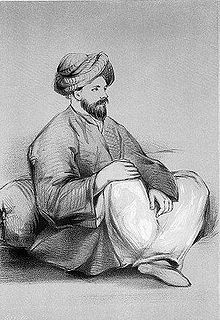
Eldred Pottinger…going local
But here, in a corner of the Cathedral in Bombay, we’re remembering his nephew Eldred (1811-1843). Eldred too went to India and served in the Bombay Artillery fighting in Afghanistan and becoming a political officer in Herat. However, things got bad and he was taken hostage for quite a while which broke his health. After being released he travelled to Hong Kong (presumably to see his uncle who by then had become the Colony’s first then Governor) but sadly died shortly after arriving. However, his memorial tablet was raised and still stands in St Thomas’s Cathedral in Bombay.
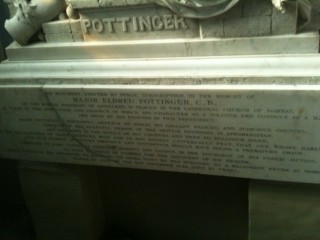
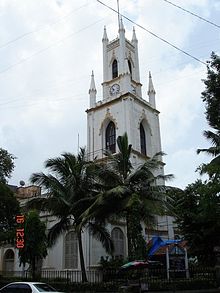
St Thomas Cathedral, Bombay
Posted: December 26th, 2012 | No Comments »
Matthias Messmer and Hsin-Mei Chuang are old Shanghailanders who’ve been writing a lot lately. Matthias published his book Jewish Wayfarers in Modern China last year, which is well worth a read. Now an interesting new book – China’s Vanishing Worlds has appeared. Matthias describes the book to me as, ‘…not a classic academic book but rather an encyclopedic photo-text collection about what has been disappearing, abandoned or destroyed in the urbanization process in rural China. It is a work of our
extensive research and field trips in the last 6-7 years to many corners of China’s rural areas. The result is more than 900 images in 336 pages and 24*30 cm in size.’ – and impressive it is too…
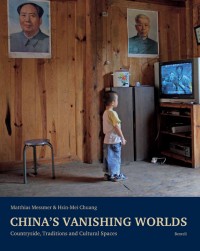
A photographic essay on the disappearance of cultural spaces and traditions in rural China
Just a few kilometers from the dramatic skylines of Chinese metropolises, we encounter a vast countryside, an often forgotten and seemingly limitless landscape stretching far beyond the glittering worlds of the large cities. Following traces of old trade routes, once-flourishing marketplaces, abandoned country estates, decrepit model villages and the sites of mystic rituals, the authors of this book have explored the vast interior of the country, where the majority of the Chinese still live. Over a period of seven years, they collected invaluable records in the form of image and text. The result is an impressive documentation of the consequences of the rapid modernization of a society that still lives under totalitarianism and a depiction of the difficult lives of the people of rural China. In this volume the scars of China’s recent history, the devastation and disappearance of once-rich cultural spaces as well as the decay of centuries-old traditions,are made visible.
Posted: December 25th, 2012 | No Comments »
It has become something of a tradition of China Rhyming to post a longer and perhaps somewhat lost Christmas related tale on Christmas Day. Last year I posted Erroll Flynn’s memoirs of the Christmas he spent cold and shivering with the Hong Kong Volunteers in Shanghai in the 1920s. Also previously we’ve had a great tale from Anthony Abbott on the Conscience of the Converted General, a tale of a most strange Christmas with a warlord.
This year we’re sticking with an old favourite of mine and China Rhyming’s – Carl Crow. This excerpt from his book Four Hundred Million Customers is from the chapter on food – Shark’s Fins and Ancient Eggs – where Carl recalls a Christmas (I think it must be around the mid-1930s) when, with his wife, he spent Christmas at a Buddhist Monastery (as ever with Crow, he puts you in your place just in case you thought you were a China specialist who did cool stuff!!).
As always with the great Ka-Loh (Carl Crow) he appears remarkably contemporary despite writing in the late 1930s about the two decades previously – food fads, emerging vegetarianism among China’s middle classes, the charming oddities of Chinese food enjoyed and, of course, the whole one upmanship joy of finding places no other foreigner has ever been or would be welcome except you!! Some things never change…and Carl Crow did the whole ex-pat China thing better than anyone now or since!!
A very merry Christmas from China Rhyming and Ka-Loh

SHARK’S FINS AND ANCIENT EGGS – CARL CROW
Long before the Christian era the Chinese, in their search for food, were experimenting with everything they could chew and swallow. They had no inherited prejudices and no religious prohibitions. Buddhism forbids the killing of animals and, as a corollary, the eating of flesh, but Buddhism was brought to China from India long after the Chinese had perfected the art of cooking and had established their food habits. The Buddhist prohibitions, which affected a very large part of the population, gave the Chinese cooks a difficult problem to solve, to provide a people accustomed to meat with a purely vegetarian diet which would be acceptable to them.
I really believe that if the Chinese cooks had not solved this problem so successfully we would not now see the magnificent Buddhist temples and monasteries which are to be found in all parts of the country as testimonials to the strength of the following of the gentle Mahatma. The Chinese cooks made the vegetarian diet so palatable that it was no hard- ship to adopt it, and what might have been a perpetual Lent became a perpetual feast.
Dr. Wu Ting Fang was a vegetarian, not because of Buddhist faith but because some lady food faddist in Washington convinced him that a vegetarian diet would prolong his life. I ate my first vegetarian Chinese meals in his home and they were very good. But I never realised how skilfully vegetarian dishes could be given the taste and appearance of meat until my wife and I were entertained at a rather sumptuous dinner by the abbot of a Buddhist monastery where we were spending our Christmas holidays. If I had not known that nothing but vegetables can be brought into a monastery kitchen and that the pious old abbot would rather commit suicide than serve so much as a spoonful of chicken liver gravy at his table, I would have thought that this was just an especially good Chinese dinner. The various dishes had not only the appearance and the taste of meat but even the texture. Since the eating of meat is so evil I wondered why it was not sinful to give this Buddhist banquet such an evil appearance, but the abbot didn’t know what I was talking about when I brought this question up, because there is nothing in the Buddhist doctrine which says anything about the avoidance of evil appearances. There are a few Protestant Christian sects which have made vegetarianism an article of faith, but shamelessly serve false replicas of pork chops and other food of sinful and evil appearance. I would like to ask them how they justify this in the light of the Biblical injunction. I know in advance that the answer will be a good one and will probably show me up in the light of a sinner who has asked a foolish question, but I am willing to take the chance because I would really like to know what the answer is. Christian theologians are notoriously skilful at exegesis and the Buddhists are not far behind them. The abbot was explaining to me the Buddhist doctrine which forbids the taking of life and, in order to make the matter understandable to me, abandoned metaphysics and confined himself to describing the harmlessness of various creatures and the benefits they bestow on man, even without providing food for him. He made out a fine case for the ox and the horse, which was easy, and gave rats and mice good reputations they did not deserve, so I asked him about mosquitoes.
‘Man should be very grateful to mosquitoes,’ he said, ‘for they save a great many lives. In the summer when it is hot the workmen in the fields get very tired and they lie down in the shade to rest. Sometimes they go to sleep, and if they sleep a long time they will get chilled and become sick. But they do not sleep long because a mosquito, on an errand of mercy, stings them and wakes them.’
During our fortnight in this Buddhist monastery, we didn’t have to exist on vegetarian food, for we had brought our provisions with us and they included all the solids and liquids which enliven the Christmas holidays. A wing of the monastery had been turned over to us and in one of the many rooms our cook set up a very serviceable kitchen. When we were about ready to return to Shanghai, and I could bring the matter up without fear of raising a dangerous issue, I asked the abbot why he had been so lenient and allowed us to bring meat, to say nothing of gin, into the monastery. His explanation was just as pleasing as his exposition of the virtues of the mosquito had been. He recalled that two years before I had come to the monastery more or less as a refugee, for I had been on a houseboat trip on the Ningpo Lakes when a typhoon struck and I had abandoned the boat and headed for the monastery as the only shelter in sight. He said he knew at the time that among the supplies my servants dragged in there was very probably some sinful meat and that he should have refused to allow them to bring it in, but I was a stranger and sick and he was afraid that if he deprived me of my regular food it might be injurious to my health. So he had said nothing about the meat and there were no dire results. On the contrary, the monastery had enjoyed an unusual prosperity. In the five hundred year history of the monastery, I was the first foreigner who had ever spent a night under its roof and they had come to the conclusion that a part of this good fortune had been due to their hospitality to me. Also, I had not behaved as they had been led to believe foreigners would behave, had been respectful at the ceremonies and had contributed liberally toward the rebuilding of the temple. He said they looked on me as a kind of lay brother, albeit a sinful one, and that I was always welcome, even with my roast turkey and boiled ham and Scotch whisky, but he warned me not to encourage any other foreigners to come to the place.
Posted: December 24th, 2012 | No Comments »
Should you have left it a bit late, or perhaps looking for a bit of reading over the holidays….may I humbly suggest the rather attractive and literary (and literally) packed Penguin China Selection Box – fully of good stuff and totally non-fattening (except to the brain cells). He Jiahong’s great Chinese crime noir Hanging Devils, Sheng Keyi’s Man Asia Prize long-listed Northern Girls and, of course (hey, it’s my blog!) Midnight in Peking….now, be honest, how lovely is that!!
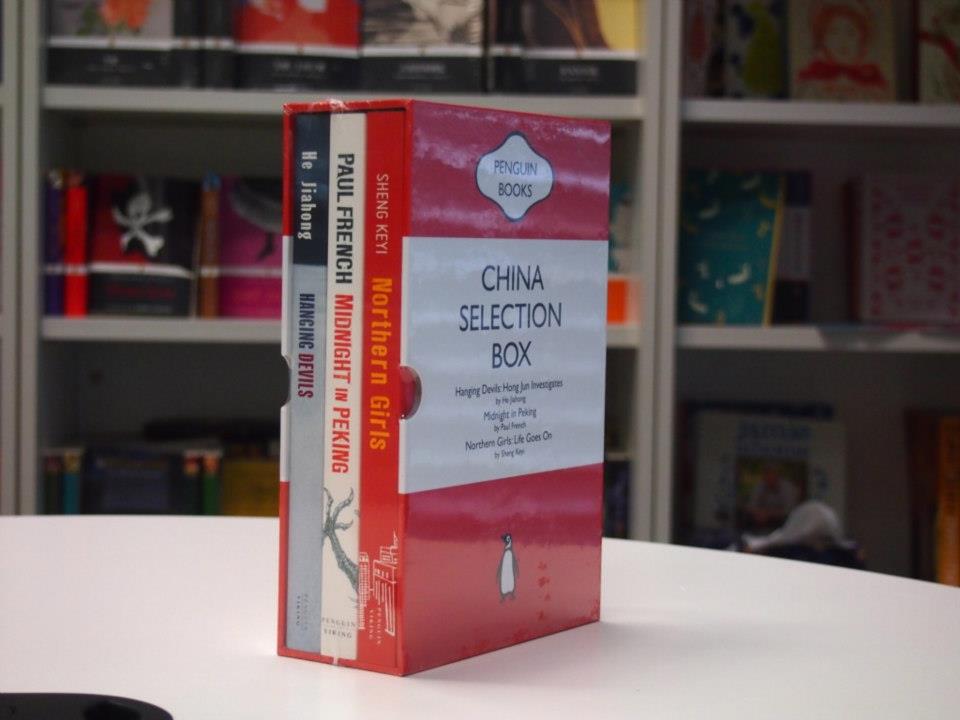
Posted: December 24th, 2012 | No Comments »
I was idling away a few moments looking through the English Heritage site the other day – always interested to see examples of Chinoiserie in posh houses…and so, as it’s the holidays and you might not want anything too heavy, here’s some pictures of Chinoiserie wallpaper:

Cobham Hall, Cobham, Kent – 1950s

Denham Place, Village Road, Denham, Buckinghamshire 1925

 Interior of the luncheon room (now known as the Chinese luncheon room), Buckingham Palace – 1900

Ramsbury Manor, Ramsbury, Wiltshire – 1922














